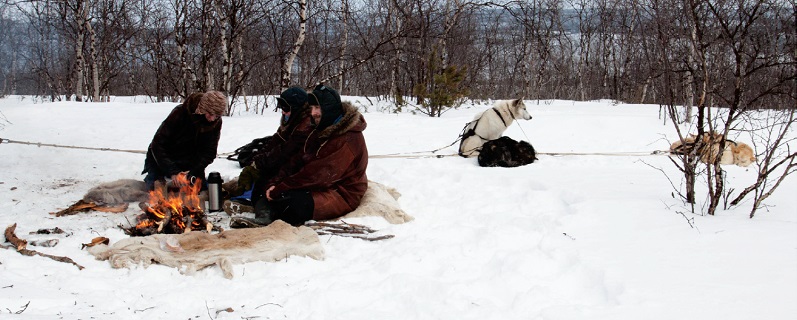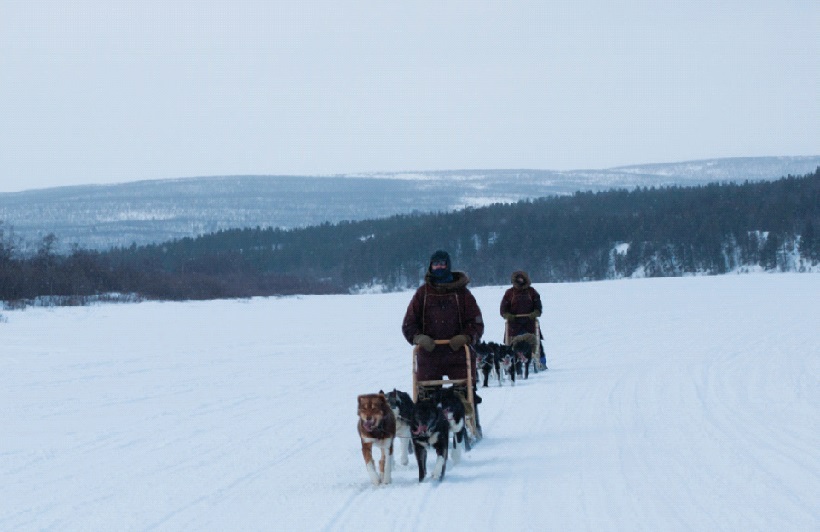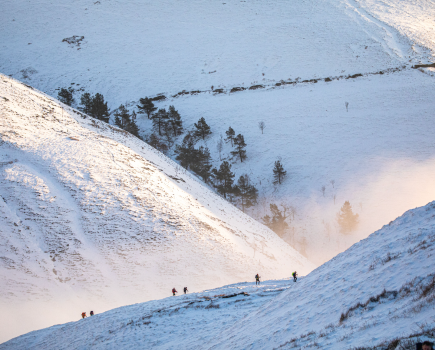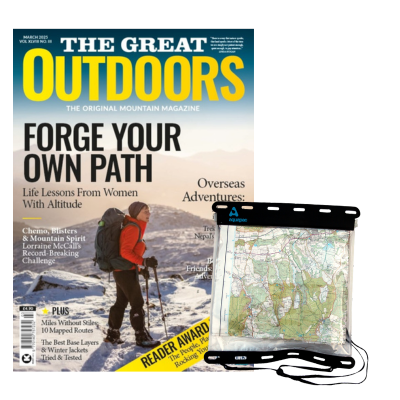Scandinavians really know how to do adventure, as Paul Beasley discovered on a dogsledding trip inside the Arctic Circle
The din of 15 huskies barking in unison hushes suddenly. In its place, the lispy hiss of sled runners sliding over snow barely whispers our presence in the wooded valley. Three teams – guides Kim and Anna in front with their six dogs, then Christine with her team of five, then me with four – arc along a frost-glittered slope and angle down towards a frozen river. The dogs, until seconds ago a pack of truculent beasts, now do what they were selectively bred to do, their genetic inheritance expressing itself in the eager push of paw upon snow.
We pick up speed down a bumpy chute.The curved wooden handlebar tugs more insistently in my hands and every unexpected hollow punches more forcefully in the pit of my stomach. Let it flow, I tell myself. Soft knees, tight grip and don’t bother with the brake. Canine faces glance furtively back at me, their hamcoloured tongues lolling askance. But what do those expressions mean, exactly: respect for my derring-do, or one last rubberneck at the condemned man? Either way, this damned hangover isn’t helping.
The land of ice
Our stop-start journey to Karasjok, a small village on Norway’s Finnmark Plateau, had kicked off in the historic port of Bergen. From here, we boarded the Hurtigruten coastal ferry, which nibbles its way northwards through the fjords. The glacier-gouged scenery, festooned at night by the Aurora Borealis, had sounded great on paper – specifically, the glossy paper the tourist brochure had been printed on. In reality, the filthy weather made everything drab. The sea was coal-grey and an endless underbelly of dirty cloud rubbed against our upturned muzzles, all-but snuffing out our chances of seeing the Northern Lights. And what of the fabled white winter? Gone the way of the mammoth, it seemed.
Once docked at the string of ports en route, we race-walked up every hill we had time to reach. And where there were no hills, we climbed bell towers. And when the churches were closed, we legged it to bars and failed to develop a taste for dried fish (one-word review: bleurgh).
By the time we finally disembarked in Tromsø, things were whitening up. Here, several degrees inside the Arctic Circle, there was snow. Lots of snow. We could finally stop muttering darkly about climate change. Muffled up against the frigid wind in our brawniest gear, we shuffled around town, slipped about in a blizzard on the slick whaleback of a bridge, and tentatively tasted the greasy tang of cods’ tongues at Emma’s Drømmekjøkken.
A short flight in a small, empty aircraft over great scoured groynes of rock got us as far as Lakselv. The airport café was closed, because it was a Saturday. Not to worry, because the bus would be here soon. Actually, no, it wouldn’t be. I’d misread the online timetable: service ‘5’, which would have met us like clockwork, actually denoted ‘Friday’. So there was no bus. Not for hours. And the airport, with its two staff, was closing. Outside, the temperature was -15°C, and the taxi rank was but a figment of the imagination. The manager, realising we were stranded, kindly drove us to a small wooden hotel, which was half-hidden in snowdrifts. After breakfast, the receptionist reassured us that the next bus was imminent, so we traipsed out to the main road through shin-high snow. But there was no bus. There was, though, a middle-aged woman walking her dog. Twenty minutes later, we were warming ourselves in a house filled with what could be a world record number of religious symbols gathered in any one place. Nonetheless, Anastasia – a Russian married to a Norwegian – restored our faith in the existence of the bus, and at the advised time we tramped out to board the predicted service. Dead beat, I nodded off repeatedly, dreaming of reindeer ghosting about in a snow-bound landscape. Then I’d wake with a start, and see… reindeer ghosting about in a snow-bound landscape. I was five years old again. It was Christmas, just in February.
At Karasjok – which, in Sami, means ‘food plate of wood’ and ‘river’, apparently – we were met by Kim and Anna, our guides. I apologized profusely for our abject lateness, but Kim smiled and said: “This is exactly when we expected you.” So it goes.
After our peristaltic journey, arriving at Engholm Husky was like passing through the dome of a snow globe into a perfect world. Here, amidst the wispy brushstrokes of downy birch trees, we stumbled about in an adult fairy tale. Inside our cosy wooden cabin were stools made from stumps, work surfaces hewn from local stone, crockery whittled from wood, lampshades made from antlers and reindeer skin, and a microwave made of, well… microwave parts, actually. But you can’t have everything, even here.
Sven Engholm, the owner, built this place himself using as many local materials as possible. An 11-time winner of the 1000km Finnmarksløpet sled-dog race, he confesses to “being infected with the dog-mushing virus, for which there is no cure – only the trail.” Indeed, there’s something ‘elsewhere’ about Sven’s taciturn character. He may be standing right in front of you in his hand-hewn kitchen, but his grey-blue eyes seem to flicker with memories of far-off frozen lands.
Pulling on the snowshoes
With an afternoon to spare, we borrow kicksleds and head to the parliament of the Sami people via the iced-up Kárášjohka river. Frustratingly, the sled runners won’t slide an inch beyond the propulsion of each thrust. Ten thigh-shredding kilometres later, we reach the parliament, which is closed. Chastened, we do the ‘noble’ thing: we call Kim and ask for a lift back.
At twilight, we meet up with Liv, Sven’s daughter, who takes us snowshoeing up a hill called ‘Halde’. At about 300m, it’s the highest point for miles and, therefore, sacred to the local Sami. To help make the effort a little less taxing, both Christine and I are harnessed to a husky, but when the path steepens into a zigzag, the dogs’ more direct approach has us yanked hither and thither through the knee-deep snow. Thankfully, we then take a straight line up a hillock straggled with trees. Above us, the great vault of the night sky sparkles with a crystal clarity, then suddenly streams with diaphanous green lights fluttering slowly overhead like gigantic chiffon scarves. We gawp upwards, our jaws hanging open, enraptured by the light shimmering on our corneas. The Sami believe these lights to be the energy of departed souls, Liv explains, but a few minutes later the show’s over, so we tread onwards. At the summit, we eat dried reindeer heart in the lee of a huge rock, which Liv says is a sieidi – a gateway to the spirit world. Beneath us, the white snake of the river valley winds through the grey garb of the plateau. We don’t linger long, though, for the bitter wind bites marrow-deep.
Heading downwards, the combination of deep snow, poor technique and canine eagerness pulls me off my feet. With my legs in the air and my head below my hips, I struggle to right myself, only succeeding when I hazard a new technique: get really annoyed and power upwards whilst ignoring the actual working angles of the joints.
Safely back at the cabin, we uncork a bottle of red wine, then another, and retire to beds warmed with hot rocks.
Meeting the dogs
The day dawns bright, dazzling my tired eyes and stretching shadows over the white woodland floor.
Job number one: get kitted out. We don heavy, unbending boots, duvet-thick salopettes, triple-layered woollen mittens as unwieldy as Lego hands, and a long tan Parka made of reindeer hide, trimmed around the hood with wolverine fur. Yes, wolverine fur.
Job number two: hitch the dogs. We march each dog from its box-like kennel over to the sled, then put them in a harness and attach that to a tugline, which links to a centre line tied to the birch-framed sled. Kim, a solidly built Dane with whiskered chops (which, Christine reckons, makes him a “a man-husky”) first leads me to Rolle. A tug-of-war ensues, but after ceding two metres I eventually bring the brown-coated beast to heel. “Not bad”, says Kim, beaming. “He usually drags newcomers 10 times as far! He’ll respect you now. This is important – these are working animals, not pets. Remember this.”

Christine’s feistiest dog is called ‘Connie’, who has unsettlingly pale blue eyes like the White Walkers in Game of Thrones. He fights and snarls all the way to the sled, and even then has to be harnessed up alone for fear that he’ll attack a neighbouring husky.
Job number three: go to school. Anna, who’s Dutch, rattles through the basics: “These are the runners… This is where you stand… This is the brake, which you push into the snow with one foot… This is how you right the sled when you crash… Never let go of the sled, or the dogs will run off into the mountains… Don’t worry about steering, or even saying ‘mush’, because we’ll be in front, and your dogs will follow our dogs like lemons.”
She means ‘lemmings’, of course, and I mean to correct her, but – hang on – didn’t she say ‘when you crash’?
Yes she did, and Kim provides us with a precise timetable of doom: “The first minute of each day – at the very least. So don’t be a hero: use the brake.”
And then, in the twinkling of an eye, we’re off. This is the moment Jack London captures so well in Call of the Wild, when the dogs are instantly transformed from “sour and sullen brutes into straining, eager, ambitious creatures”. Well, apart from Connie, who is both sour and eager at the same time.
We barrel downhill, and like the spirit of Obi Wan Kenobi talking to Luke Skywalker, I hear Kim’s voice telling me to “use the brake, Paul”. But I’m a hypoglycemic child let loose in a sweet shop, and I simply don’t possess the self-control needed to shimmy onto the steel claw. Weeeee!
Hang on, though: didn’t Kim say that going too fast downhill endangers the dogs, because the sled could hit them in the back? I just can’t let that happen.
Moving as dextrously as Superman in a kryptonite dealership, I ease my weight onto my left foot so I can reach the brake with my right, but by the time my leaden boot presses down, the sled has taken off over one of the hollows. Adrenaline surges through my body, and I start to sense in slow-motion. The outside world is now moving slowly enough for me to see the sled list in mid air, and slowly enough for me to see the worried faces looking back at me, and to recall Kim telling me to “Never let go of the handle”, and for me to register the sled landing on one runner and shivering on impact. But it’s still moving way too fast for me to stop my right hand being shaken off the handle or prevent my feet from being shucked clean off the runners. The sled bounces upwards and is dragged anticlockwise by the sack of spuds formerly known as Paul Beasley. Down we go again, the ground broadsiding my left shoulder and breaking my grip entirely. I rebound off the hard earth then come to rest, head-first, in a snowdrift. Radiohead were right: gravity does always win. I get up and start running, and see that Christine is running too. A little further on, Anna is bringing my dogs under control, and at the edge of the river, Kim has Stine’s sled in one hand and his in another. Phew!
We dust ourselves down, stand back on the runners, and try again. Our progress, impeded by a new-found addiction to braking, is jittery, and the dogs aren’t happy about being held back. With each passing kilometre, though, we regain confidence, letting the sled run free as we weave across the ice.
Just beyond Karasjok, we turn left and climb back up the valley. My straining dogs now look at me with a different expression: don’t just stand there, fat boy, give us some help. Still holding the handle, I jump off and stride between the runners, beginning to huff and puff like a steam train. My team gains on the sleds ahead, but it’s hard work running up hill through snow when you’re wearing giant clod-hoppers.
Five sweaty minutes later, we reach a plateau, and as my heart rate drops I begin to register our surroundings: wide vistas of snow bordered by spindly trees stripped bare by winter’s grip, and no other souls in sight. The soundscape is even more starkly scrubbed back: nothing but huskies panting and the endless shush of runners on snow. Travel has never been so tranquil.
We cross a frozen lake under a powder blue sky, then glide through a succession of copses, shifting our weight more smoothly with every turn. Several kilometres drift by in a sort of mobile meditative state, then we stop for lunch, and wade through two foot of snow to scavenge dead wood for a fire. Reindeer furs are laid out, and I collapse in an exhausted heap. Once the flames are licking upwards, we toast ham and cheese sandwiches, unlocking them from their frozen-solid state.

Back on the trail, Kim steps up the challenge, veering off obvious tracks and into virgin snow. The dogs disappear, then reappear, as they bound forwards through the husky-deep powder. We plough into a woodland, shifting our weight into tight turns while ducking branches that threaten to thwack us asunder. Back up on the plateau, a frigid headwind conducts a cryogenic experiment on my exposed hooter.
Again, time flies, and as the light dwindles we pull into a copse and park up near a tent. “It’s cosy time”, shouts Kim, and we follow his lead by stroking each husky in turn, then secure them for the night. The dogs curl up on the snow, wrapping tails round noses.
While Anna and Stine axe their way through the frozen dog food, mix it with hot water and dole it out for dinner, Kim and I skittle down to a small lake, bore a hole through the ice and dangle toy-sized tackle into the water, but nothing bites for an hour, so we shuffle, numb-bummed, back to the insulated tent.
Inside, a wood-burning stove radiates heat and camp beds are piled with furs. A dinner of rice, sausages and a lip-smacking cloudberry jam passes almost without incident, although Christine can’t resist a wry comment about Kim’s knitted long johns. “I made those for him”, says Anna, warily, but digestive biscuits are then dealt out, which we top with jam and a sweet brown cheese called brunost, and the awkward moment passes.
Talk turns to heroes. Kim puts forward the case for Ernest Shackleton, who managed to get everyone back alive from the ill-fated Imperial Trans-Antarctic Expedition of 1914–17. His men, he figured, were better off alive than fixed forever – by some dead reckoning – in a book of record.
My Polar paragon is Frijtof Nansen, a Norwegian explorer who let his big-ribbed ship, Fram, become trapped in the ice at the Siberian Islands and simply waited for the current – as per his theory – to take them to the North Pole. It sort-of worked, but progress stalled at 84° North, so on 14th March 1895 Nansen and colleague Johansen ventured further on dogsleds. Having reached a record 86° North, they turned back, and for months struggled south over pack ice. Nansen, Johansen and the entire crew of Fram ultimately made it home safely, but the dogs fared considerably less well. Booze follows, then sleep, and I dream about herding reindeer.
The final day
The next morning, my own mettle is immediately tested. The huskies rev themselves into a barking fury, I release the brake and we shoot forwards like a silent dragster. The trees stand tight together, the turns are sharp, and the sled is skittish on the crisp surface of the snow. We exit the woodland equivalent of a chicane at breakneck speed, and the sled begins to slingshot out behind the dogs, hurtling me towards a trunk. I have a split-second choice to make: hold on and be slammed into a tree, or bale out and hope my trajectory takes me clear of the trunk. I do – I tell myself – what Shackleton would have done, and let go of the handle, landing safely some 10 metres away, face-down in a drift, and emerge with a mouth full of snow. I start running, and see that Christine has been dislodged too, and that Anna and Kim have once again snagged the dogs before they reached open ground.
After that slight hiccup, we’re quickly back into the rhythm. Above us, the sky is slathered with clouds and the light flat. A vacant concentration soon takes hold: I don’t have to think, just do. We move serenely across the widescreen plateau, pass over the wind-rendered ice that ridges the frozen lakes, and sway smoothly through the trees, floating free from the wheels of time. In the blink of an eye, we’re back at Engholm Husky, and I feel like I’m waking from a trance.
After dinner, under a clearing sky, we mosey about by the kennels and set the camera up, more in hope than expectation. But wait! Isn’t that..? Surely… Yes! It is!
A wisp of green smoke high above us starts to wind down towards the ground. I angle the camera and fire away, dimly recalling the science behind this spectacle – something about solar winds and magnetospheres, isn’t it? Whatever! Behind the camera, though, I feel frustratingly detached from my surroundings, so I step away, clear my mind, and look up in wordless wonder. Time slackens once more, along with my jaw, as the patterns of light grow more complex. Great green swirls flare at the hem like magnesium lit in a science class, then green-and-red bars run across a billowing curtain as if it’s made of immense lightsabers – each one illuminating briefly in turn.

When the lights begin to fade, I realise I’ve been softly singing some words from a Spiritualized song: “And it takes up all my time / And it lays me back a while / Makes me feel like I’m a child. Let it flow.” It’s a solemn gospel-style hymn, seemingly sung by a celestial choir – whose voices reverberate through all of space and time. This is the intended effect, no doubt, because it’s written by one ‘J. Spaceman’, a sonic explorer of mind-altered states who once recorded a track called ‘Taking Drugs to Make Music to Take Drugs To’. But who needs drugs when you’ve got dogs instead, you’re inside the Arctic Circle, and the sky is alive with spirits.
The essentials
Getting there: Information on Hurtigruten departures from Bergen to Tromsø is available here: www.hurtigruten.com. It is also possible to fly to Tromsø direct from Gatwick via Norwegian (www.norwegian.com). Nordic regional airline Wideroe (www.wideroe.no) flies from Tromsø to Lakselv. An alternative route is to fly to Ivalo in Finnish Lapland, via Helsinki.
Winter activities: Engholm Husky (www.engholm.no) offer a range of dogsled tours, from the three-day Beyond the Beaten Tracks to the 11-day Expedition to the Arctic Sea. Other trips include cross-country skiing and a week helping with the Sami reindeer migration. If you’d rather not arrange your trip independently, dogsledding packages inside the Arctic Circle are available from Artisan Travel (www.artisantravel.co.uk).
Walking in Finnmark: If you’d prefer to rely on your own two feet to explore this area of Norway, it’s best to wait at least until late January when daylight starts to return. Temperatures towards the end of the winter hover around -5°C at the warmest in the mountains, and snow can be present right through to the end of spring. The mountain huts stay open throughout the winter but thick snow makes these difficult to reach on foot; as such they are mainly used by cross-country skiers or snowshoers. Go to visitnorway.co.uk for more information on winter skiing and snowshoeing and on hiking opportunities for warmer weather.
Northern Lights: The Aurora Borealis is most easily seen on the darkest, clearest nights between January and March . The most intense periods of auroral activity occur in the middle years of the sun’s 10-15 year solar cycle.
History & culture: Tromsø’s Polar Museum has an excellent display of Norwegian exploration paraphernalia. In Karasjok, the Sami Parliament building (which Paul and Christine managed to visit at the second attempt) provides an interesting insight into the intersection of indigenous, national and international politics; the village also hosts reindeer races over the Easter period.








